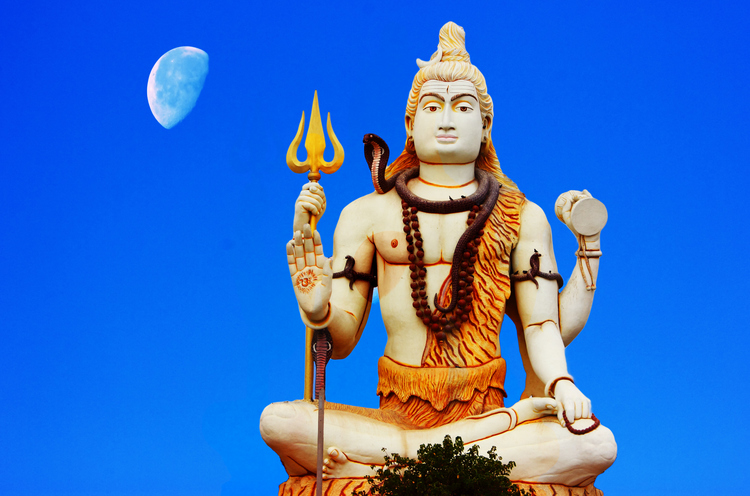
- This event has passed.
Maha Shivaratri

Maha Shivratri is an annual festival honoring Shiva, the Hindu God of destruction. People celebrate by fasting for a whole day and staying awake all night. They also chant hymns and sing devotional songs, called bhajans.
Is Maha Shivaratri a Public Holiday?
Maha Shivaratri is not a public holiday. Businesses have normal opening hours.
It is a solemn Hindu festival devoted to introspection and meditation. The day reminds worshippers to work towards overcoming darkness and ignorance.
The Great Night of Shiva
Maha Shivratri, which means the great night of Shiva in Hindi and Sanskrit (Maha = great, Ratri = night), is one of 12 Shiv Ratris during the year. The 14th day of the Waning Moon period of every lunar month is devoted to Shiva. These nights are also known as Masik (monthly) or Maas Shivratri.
When is Maha Shivratri?
- In South Indian calendars, it falls on the 14th day (chaturdashi tithi) of the Waning Moon period of the Hindu month of Magha.
- In North Indian calendars, Maha Shivratri falls on the 13th and 14th day of the Waning Moon (Krishna paksha) in the month of Phalguna.
Where is Maha Shivratri Celebrated?
In India, Maha Shivaratri is a Gazetted Holiday, which means that all central government employees have a day off. Indian states have their own rules about granting the day off.
In the Indian state of Jammu and Kashmir, Maha Shivratri is called Herath. Unlike the rest of India, it is celebrated on the 13th (triyodashi) day of Phalguna. The next day is spent feasting.
Where is Maha Shivratri Celebrated?
In India, Maha Shivaratri is a Gazetted Holiday, which means that all central government employees have a day off. Indian states have their own rules about granting the day off.
In the Indian state of Jammu and Kashmir, Maha Shivratri is called Herath. Unlike the rest of India, it is celebrated on the 13th (triyodashi) day of Phalguna. The next day is spent feasting.
Fasting, Devotional Songs, Night-Long Vigils
Maha Shivratri is celebrated differently in different communities and regions. Devotees usually fast (vrat) for 24 hours and stay awake during the night, chanting sacred mantras and singing devotional songs called bhajans in praise of Shiva. One of the most repeated chants during the occasion is om Namah Shivaya.
They visit Shiva temples to end their fast, burning incense and bathing the lingam or linga with rose water, milk, and honey. This ritual is called puja. The lingam is a phallus-shaped representation of Shiva.
Cannabis and Fairs
Although Maha Shivratri is a solemn holiday, many Hindus like to celebrate it with lively fairs. Especially towns and villages with temples host these fairs for the believers who come to pray to Shiva.
A unique tradition associated with the Maha Shivratri celebrations is the consumption of thandai, a drink made of cannabis (bhang), sweet almonds, and milk.
Worship Through Dance
In many parts of India, including Tamil Nadu and Maharashtra, temples organize dance festivals called Natyanjali. During the multi-day festival, traditional dancers use their art to worship Natraj, Shiva’s incarnation as the lord of dance.
The Many Legends of Maha Shivratri
- Churning of the seas (Samudra Manthan): According to one story, the gods (devas) and demons (asuras) churned the mythical seas to extract amrita, the nectar of immortality. As they churned, poison emerged from the sea. To save the world, Lord Shiva consumed the poison, which turned his neck blue. Because of this, he is also often called Neelkanth (blue throat in Sanskrit).
- The heavenly dance of creation: Some believe that Maha Shivratri is the night when Shiva performed the tandava, the powerful dance of creation, preservation, and destruction.
- Shiva’s union with Parvati: In another myth, Shiva is said to have married Parvati, on this day after she fasted for him. Parvati is the Hindu goddess of power, devotion, and motherhood. Today, many women follow goddess Parvati’s steps and fast during Shivratri for the long lives of their husbands and sons. Those who are not married, fast and pray for a devoted husband like Shiva.
- Shiva as the punisher: According to some legends, the festival of Shivaratri commemorates the time Shiva intervened in an altercation between Brahma and Vishnu. Brahma is the God of creation, and Vishnu is the God of preservation. Angered by their disagreement, Shiva took the shape of a raging fire. Another story has Shiva cursing Brahma after he fought with Vishnu.
God Shiva: The Destroyer
In Hinduism, Shiva is one of the three supreme lords, the other two being Brahma and Vishnu.
Also known as Mahadeva, the great God, Shiva destroys to create. He is a kind god who lives a simple life on Mount Kailasa. He is also depicted as an angry god who destroys ignorance, darkness, and selfishness. His other names include Rudra, Shankar, Mahesh, and Bholenath.
Shiva is often represented as sitting cross-legged with a snake coiled around his neck and his hair piled high with a Crescent Moon in it and the river Ganges flowing from it. On his forehead is his third eye, which destroys the world when opened. The trident is his weapon of choice.
In the Shaivite tradition within Hinduism, Shiva is the supreme being, while in Shaktism, Shiva is seen as inseparable from the goddess Shakti.
